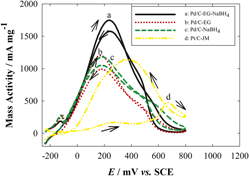Crossref Citations
This article has been cited by the following publications. This list is generated based on data provided by
Crossref.
Chen, Jinwei
Li, Yuanjie
Gao, Zichen
Wang, Gang
Tian, Jing
Jiang, Chunping
Zhu, Shifu
and
Wang, Ruilin
2013.
Ultrahigh activity of Pd decorated Ir/C catalyst for formic acid electro-oxidation.
Electrochemistry Communications,
Vol. 37,
Issue. ,
p.
24.
Chen, Jinwei
Li, Yuanjie
Liu, Shuangren
Wang, Gang
Tian, Jing
Jiang, Chunping
Zhu, Shifu
and
Wang, Ruilin
2013.
Remarkable activity of PdIr nanoparticles supported on the surface of carbon nanotubes pretreated via a sonochemical process for formic acid electro-oxidation.
Applied Surface Science,
Vol. 287,
Issue. ,
p.
457.
Chen, Jinwei
Zhang, Jie
Jiang, Yiwu
Yang, Liu
Zhong, Jing
Wang, Gang
and
Wang, Ruilin
2015.
Enhanced formic acid electro-oxidation reaction on ternary Pd-Ir-Cu/C catalyst.
Applied Surface Science,
Vol. 357,
Issue. ,
p.
994.
Li, Yue
Lu, Di
Zhou, Liqun
Ye, Menglin
Xiong, Xing
Yang, Kunzhou
Pan, Yaxi
Chen, Menghuan
Wu, Peng
Li, Tian
Chen, Yuting
Wang, Zheng
and
Xia, Qinghua
2016.
Bi-modified Pd-based/carbon-doped TiO2 hollow spheres catalytic for ethylene glycol electrooxidation in alkaline medium.
Journal of Materials Research,
Vol. 31,
Issue. 23,
p.
3712.
Jiang, Kun
Zhang, Jie
and
Chen, Jinwei
2018.
Enhanced catalytic activity of ternary Pd-Ni-Ir nanoparticles supported on carbon toward formic acid electro-oxidation.
Journal of Solid State Electrochemistry,
Vol. 22,
Issue. 6,
p.
1941.
Puppin, Lara G.
Khalid, Mohd.
da Silva, Gelson T.T.
Ribeiro, Caue
Varela, Hamilton
and
Lopes, Osmando F.
2020.
Electrochemical reduction of CO2 to formic acid on Bi2O2CO3/carbon fiber electrodes.
Journal of Materials Research,
Vol. 35,
Issue. 3,
p.
272.
Redón, Rocío
González-García, Tania
Espinoza-Flores, Lorena
Reyes-Mosso, Alfonsina
Martin, Erika
and
Ugalde-Saldivar, V. M.
2022.
Palladium Nanoparticles from Different Reducing Systems as Heck Catalysts.
Catalysis Letters,
Vol. 152,
Issue. 1,
p.
151.
Tan, Xing
Chen, Shiming
Yan, Dafeng
Du, Ruixing
Zhong, Qitong
Liao, Longfei
Tang, Zhenchen
and
Zeng, Feng
2024.
Recent advances in Ni-based catalysts for the electrochemical oxidation of ethanol.
Journal of Energy Chemistry,
Vol. 98,
Issue. ,
p.
588.
Tan, Xing
Du, Ruixing
Zhong, Qitong
Liao, Longfei
Chen, Huanhao
Tang, Zhenchen
Yan, Dafeng
Chen, Shiming
and
Zeng, Feng
2025.
Au–Ni synergy for enhanced electrochemical oxidation of ethanol over Au/Ni foam electrode.
Catalysis Science & Technology,
Vol. 15,
Issue. 3,
p.
933.
